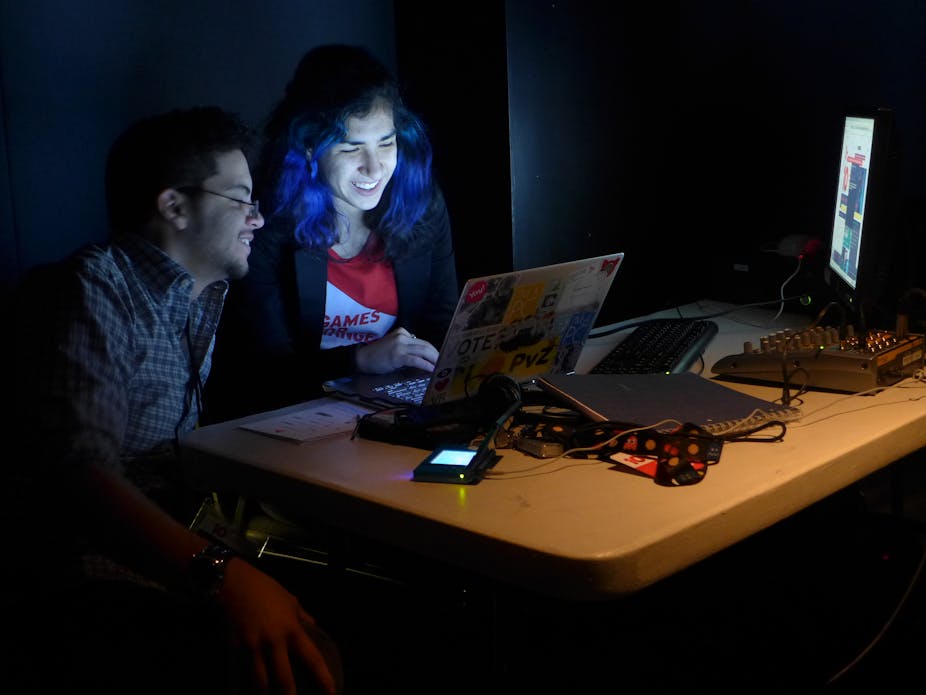Most of us are only too aware of the seemingly intractable problems we’re facing within healthcare, education, community building, environmental sustainability and regional conflict. But could interactive games provide part of the solution?
The organisers of the 11th annual Games for Change Festival in New York (April 22-26) seem to think so. In conjunction with the Tribeca Film Festival, the festival will unite game creators, policy makers and educators.
“Gaming for social good” – the use of digital games or elements of games for non-entertainment purposes – is a large arena that includes serious games, game-based learning, games with a purpose and gamification (or game thinking and mechanics in a non-game context).
Research from the last decade has shown that, in the right context, games can provide an effective and engaging medium that allows us to explore personal identity, actively participate in learning, build social connections and take part in problem solving and decision making in a “safe-fail” space.
Well-designed social-good games can produce positive outcomes by tapping into our intrinsic motivations and positive emotions.
There are games that tackle social issues, such as Darfur is Dying, which raises awareness on the plight of refugees in western Sudan; FreeRice, which provides a sponsorship platform for tackling world hunger; and RecycleBank, which encourages household recycling and waste reduction.

The use of digital games for non-entertainment purposes is nothing new. Its origins can be traced back to the early 1950s with the introduction of the first computers, when chess and checkers were programmed as computer games by scientists to run research in computer science and artificial intelligence.
But it was only when the the Cold War took hold that significant investment in digital games was made by the military to simulate war games for training and battle strategy evaluation.
Today, outside of the military, investment in games for social impact are undertaken by universities, philanthropic foundations and governments in conjunction with private sector organisations, and supported by advocacy organisations such as Games for Change and Games for Health.
In the healthcare sector, games have been used across diverse fields such as research, rehabilitation, medical treatment, education and training. And from these, the following are some pertinent examples.
Health and wellness games
Medical research
The University of Washington developed the multi-player online puzzle game FoldIt in 2008, which focused players on predicting the behaviour patterns of protein structures with potential applications in the treatment of the AIDS virus, cancer and Alzheimers disease.

The problem of how to configure the structure of an enzyme, M-PMV retroviral protease – a challenge that had stumped scientists for 15 years – was solved in just 10 days after it was presented to 240,000 FoldIt players in 2011. This has been a keystone example of how the combination of a multiplayer games, crowd-sourcing and distributed computing can be used as a new and innovative form of collaborative research and problem solving.
FoldIt spawned other medical and healthcare game projects, including cancer research with games such as the GeneGames, EteRNA, EyeWire and Phylo.
Rehabilitation
Videogames using virtual reality have been used in clinical trials for the rehabilitation of stroke patients to recover function in their disabled limbs. Both the Fruit Ninja game on Xbox Kinect and virtual tennis games on the Nintendo Wii platform were found to show significant benefit to patients and act as a good adjunct to conventional therapy.
There are now several iPad game apps on the market designed to assist with rehabilitation, communication and emotion management, including a wide range of games for stroke patients.
Medical treatment
Various games have been used as assistive tools for patients to manage their illnesses (while collecting data at the same time to further medical research).
The mobile game Pain Squad was developed to help young cancer patients record their pain levels, and Re-Mission was also aimed at young cancer patients to help them manage their condition better and encourage them to adhere to their treatments.
Healthcare games of this type been successful as they provide immediate feedback and visualisation of the patient’s condition in a novel, interactive and fun way. Most importantly (depending on the game, the illness and the individual) gameplay helps the patient feel empowered, and in control of a situation that more often than not makes them feel isolated, depressed and helpless.
Many other games or gamified tools are used, such as Triage Simulator, for training medical practitioners on emergency response, and gamified mobile apps that focus on building exercise, diet, awareness of substance abuse and behaviour modification.
It’s still early days in the research and testing of games for social impact. Not all problems can be solved with a game-based solution, and any use of games must of course be undertaken as part of an integrated approach.
But with increasing pressure on the health system, alongside greater focus on prevention and self-managed care, games are showing strong potential as an innovative source of cost-effective and accessible solutions – just as they are in many other areas of social concern.

